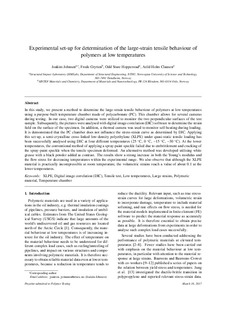| dc.contributor.author | Johnsen, Joakim | |
| dc.contributor.author | Grytten, Frode | |
| dc.contributor.author | Hopperstad, Odd Sture | |
| dc.contributor.author | Clausen, Arild Holm | |
| dc.date.accessioned | 2017-03-20T08:12:06Z | |
| dc.date.available | 2017-03-20T08:12:06Z | |
| dc.date.created | 2016-07-11T13:29:44Z | |
| dc.date.issued | 2016 | |
| dc.identifier.citation | Polymer testing. 2016, 53 305-313. | nb_NO |
| dc.identifier.issn | 0142-9418 | |
| dc.identifier.uri | http://hdl.handle.net/11250/2434622 | |
| dc.description.abstract | In this study, we present a method to determine the large-strain tensile behaviour of polymers at low temperatures using a purpose-built temperature chamber made of polycarbonate (PC). This chamber allows for several cameras during testing. In our case, two digital cameras were utilized to monitor the two perpendicular surfaces of the test sample. Subsequently, the pictures were analysed with digital image correlation (DIC) software to determine the strain field on the surface of the specimen. In addition, a thermal camera was used to monitor self-heating during loading. It is demonstrated that the PC chamber does not influence the stress-strain curve as determined by DIC. Applying this set-up, a semi-crystalline cross-linked low-density polyethylene (XLPE) under quasi-static tensile loading has been successfully analysed using DIC at four different temperatures (25 °C, 0 °C, −15 °C, −30 °C). At the lower temperatures, the conventional method of applying a spray-paint speckle failed due to embrittlement and cracking of the spray-paint speckle when the tensile specimen deformed. An alternative method was developed utilising white grease with a black powder added as contrast. The results show a strong increase in both the Young’s modulus and the flow stress for decreasing temperatures within the experimental range. We also observe that although the XLPE material is practically incompressible at room temperature, the volumetric strains reach a value of about 0.1 at the lower temperatures. | nb_NO |
| dc.language.iso | eng | nb_NO |
| dc.publisher | Elsevier | nb_NO |
| dc.title | Experimental set-up for determination of the large-strain tensile behaviour of polymers at low temperatures | nb_NO |
| dc.type | Journal article | nb_NO |
| dc.type | Peer reviewed | nb_NO |
| dc.source.pagenumber | 305-313 | nb_NO |
| dc.source.volume | 53 | nb_NO |
| dc.source.journal | Polymer testing | nb_NO |
| dc.identifier.doi | 10.1016/j.polymertesting.2016.06.011 | |
| dc.identifier.cristin | 1367451 | |
| dc.relation.project | Norges forskningsråd: 228513 | nb_NO |
| dc.description.localcode | © 2016 Elsevier Ltd. All rights reserved. This is the authors' accepted and refereed manuscript to the article. Locked until 16th of june 2018 due to copyright restrictions | nb_NO |
| cristin.unitcode | 194,64,45,0 | |
| cristin.unitname | Institutt for konstruksjonsteknikk | |
| cristin.ispublished | true | |
| cristin.fulltext | postprint | |
| cristin.qualitycode | 1 | |
